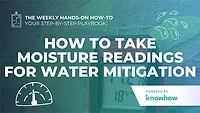Weekly Hands-on How-To powered by KnowHow
How to Take a Lead Paint Sample for Accurate Testing

All images provided by KnowHow.
Lead paint might not be something you encounter every day, but when you’re working on older properties like historic homes or long-standing structures, lead paint can show its ugly head. Knowing how to properly handle it not only keeps your team in compliance with regulations but also protects the safety of everyone involved.
Taking accurate samples is the first step, and while the process may seem straightforward, it demands precision, the right tools, and detailed documentation. In this how-to, powered by KnowHow, we’ll guide you through the process step by step, ensuring every sample is collected safely, accurately, and in compliance with industry standards.
Please ensure you have all the proper licenses and required certification to handle lead in your State before taking a lead sample.
Let’s get started and make sure you’re prepared to handle lead testing with confidence.
Step 1: Gather Required Materials
Preparation is key to ensure accurate results and a smooth sampling process. Assemble these tools and materials before you begin:
- Containers: Use resealable, rigid-walled containers (e.g., screw-top plastic centrifuge tubes) to store samples.
- Safety gear: Include personal protective equipment (PPE), gloves, and protective sheeting.
- Tools: Cutting tools (razor knives, scrapers), a steel ruler with metric divisions, and a flashlight.
- Miscellaneous: Cleaning cloths, masking/duct tape, white paper for collection trays, and a permanent marker.
Having these materials ready ensures the process goes smoothly, with minimal interruptions.
Step 2: Document Test Location and Sample Details
Complete the Paint Chip Sample Collection Form with essential details such as:
- Project or client name.
- Sampling site description.
- Collector’s name.
Additionally, label each sample container with a unique identifier and the dimensions of the sampled surface. These steps create a clear record, which is vital for traceability and analysis.
Step 3: Outline the Collection Area
Marking the sampling area is where precision begins. Use a ruler to draw the outline of the area to be sampled on the painted surface, ensuring it meets the laboratory’s minimum size requirement (typically at least one square inch).
- Score the outline with a razor knife, retracing until clean edges are formed.
- Record the dimensions of the outlined area on the form.
- Clean your ruler to avoid contamination.
This careful preparation ensures a clear, reliable sample for analysis.

Step 4: Set Up the Paint Chip Collection Tray
Proper setup is essential to ensure accurate sample collection and minimize contamination. Depending on the orientation of the surface, here’s how to prepare your collection tray:
- Horizontal Surfaces: Use a sheet of white paper to create a funnel. For smaller areas, cut the paper to size so it fits the sampling location without interfering with your work.
- Vertical Surfaces: Secure a clean sheet of white paper beneath the sampling area by attaching a strip of tape along the top edge. Fold the bottom corners of the paper together to form a funnel, securing it with additional tape. This funnel ensures paint chips are collected without spillage.
- Overhead Surfaces: Similar to vertical surfaces, create a closed-bottom funnel with white paper. Attach it directly below the sampling area or affix it to a ladder positioned underneath the surface. Ensure it remains stable and does not obstruct access to the painted surface.
Step 5: Remove the Paint Chip Sample
With the area prepared, use a razor knife or scraper to carefully remove the paint chip. Follow the scored lines, sliding the tool gently to avoid scattering fragments. Taping a paper funnel, or plastic bag underneath the sample area can help ensure no chips are dropped.
If the sample proves difficult to remove, adjust your tools or technique to maintain the chip’s integrity.

Step 6: Transfer the Sample to the Collection Container
Carefully transfer the collected sample into the rigid-walled container, ensuring no spillage. Seal the container securely. If you’ve used a paper funnel or tray, dispose of it in a trash bag. Reusable trays should be thoroughly cleaned before reuse.
Step 7: Clean Tools
After sampling, clean all cutting and scraping tools with a wet wipe or cloth to remove debris. This prevents cross-contamination between samples.
Step 8: Verify Documentation
Review all labels and forms to confirm that each sample is properly identified and recorded. This step ensures that the analysis results will be accurate and traceable.
Step 9: Submit Samples for Analysis
Send the sealed sample to an NLLAP-recognized laboratory. Verify that the lab is accredited and capable of analyzing the sample size you’ve collected.
Step 10: Record and Report Results
When results are returned, document them and provide a report to the client within 30 days. Retain all records, including the Paint Chip Sample Collection Form, for three years as per EPA guidelines.
Chipping Away at Lead Testing Challenges with KnowHow
Lead testing is a must in restoring older properties, and collecting accurate paint samples is the foundation of safe and compliant work. By following this process, you’ll ensure that every sample is collected, documented, and submitted with precision.
If you don’t remember how to test for lead paint off the top of your head, you’re not alone! That’s why having instant access to clear guidance can make all the difference, and that’s where KnowHow comes in. From step-by-step training during onboarding to instant on-the-job support, KnowHow ensures your team is equipped to handle lead testing processes and every other challenge that comes your way.
Ready to streamline your workflow and boost confidence in your results? Visit tryknowhow.com today and see how we can help make every job safer, smarter, and more efficient.
Looking for a reprint of this article?
From high-res PDFs to custom plaques, order your copy today!






